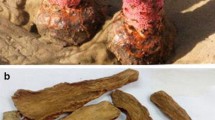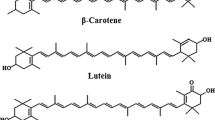Abstract
The objective of the present study was to compare the toxicity and availability of Fe(II) and Fe(III) to Caco-2 cells. Cellular damage was studied by measuring cell proliferation and lactate dehydrogenase (LDH) release. The activities of two major antioxidative enzymes [superoxide dismutase (SOD) and glutathione peroxidase (GPx)] and differentiation marker (alkaline phosphatase) were determined after the cells were exposed to different levels of iron salts. The cellular iron concentration was investigated to evaluate iron bioavailability. The results show that iron uptake of the cells treated with Fe(II) is significantly higher than that of the cells treated with Fe(III) (P<0.05). Fe(II) at a concentration >1.5 mmol/L was found to be more effective in reducing cellular viability than Fe(III). LDH release investigation suggests that Fe(II) can reduce stability of the cell membrane. The activities of SOD and GPx of the cells treated with Fe(II) were higher than those of the cells treated with Fe(III), although both of them increased with raising iron supply levels. The results indicate that both Fe(II) and Fe(III) could reduce the cellular antioxidase gene expression at high levels.
Similar content being viewed by others
References
Baker, S.S., Baker, R.D.Jr., 1992. Antioxidant enzymes in the differentiated Caco-2 cell line. In Vitro Cellular & Developmental Biology-Animal, 28(9–10):643–647. [doi:10.1007/BF02631040]
Cai, L., Tsiapalis, G., Cherian, M.G., 1998. Protective role of zinc-metallothionein on DNA damage in vitro by ferric nitrilotriacetate (Fe-NTA) and ferric salts. Chemico-Biological Interactions, 115(2):141–151. [doi:10.1016/S0009-2797(98)00069-6]
Chamnongpol, S., Dodson, W., Cromie, M.J., Harris, Z.L., Groisman, E.A., 2002. Fe(III)-mediated cellular toxicity. Molecular Microbiology, 45(3):711–719. [doi:10.1046/j.1365-2958.2002.03041.x]
Gan, L.L., Dhiren, R.T., 1997. Applications of the Caco-2 model in the design and development of orally active drugs: elucidation of biochemical and physical barriers posed by the intestinal epithelium. Advanced Drug Delivery Reviews, 23(1–3):77–81. [doi:10.1016/S0169-409X(96)00427-9]
García-Alfonso, C., Lopez-barea, J., Sanz, P., Repetto, G., Repetto, M., 1996. Changes in antioxidative activities induced by Fe(II) and Fe(III) in cultured vero cells. Archives of Environmental Contamination and Toxicology, 30(4):431–436. [doi:10.1007/BF00213392]
Glahn, R.P., Wien, E.M., van Campen, D.R., Miller, D.D., 1996. Caco-2 cell iron uptake from meat and casein digests parallels in vivo studies: use of a novel in vitro method for rapid estimation of iron bioavailability. Journal of Nutrition, 126(1):332–339.
Glahn, R.P., Lee, O.A., Yeung, A., Goldman, M.I., Miller, D.D., 1998. Caco-2 cell ferritin formation predicts non-radiolabeled food iron availability in an in vitro digestion/Caco-2 cell culture model. Journal of Nutrition, 128(9):257–264.
Glahn, R.P., Cheng, Z.Q., Welch, M.R., 2002. Comparison of iron bioavailability from 15 rice genotypes: studies using an in vitro digestion/Caco-2 cell culture model. Journal of Agricultural and Food Chemistry, 50(12):3586–3591. [doi:10.1021/jf0116496]
Kloots, W., Op den Kamp, D., Abrahamse, L., 2004. In vitro iron availability from iron-fortified whole-grain wheat flour. Journal of Agricultural and Food Chemistry, 52(26):8132–8136. [doi:10.1021/jf040010+]
Kuratko, C.N., 1998. Decrease of manganese superoxide dismutase activity in rats fed high levels of iron during colon carcinogenesis. Food and Chemical Toxicology, 36(9–10):819–824. [doi:10.1016/S0278-6915(98)00029-5]
Kuratko, C.N., 1999. Iron increases manganese superoxide dismutase activity in intestinal epithelial cells. Toxicology Letters, 104(1–2):151–158. [doi:10.1016/S0378-4274(98)00359-2]
Mccord, J.M., 1996. Effects of positive iron status at a cellular level. Nutrition Reviews, 54(3):85–88.
Núñez, M.T., Tapia, V., Toyokuni, S., Okada, S., 2001. Iron-induced oxidative damage in colon carcinoma (Caco-2) cells. Free Radical Research, 34(1):57–68. [doi:10.1080/10715760100300061]
Okada, T., Narai, A., Matsunaga, S., 2000. Assessment of the marine toxins by monitoring the integrity of human intestinal Caco-2 cell monolayers. Toxicology in Vitro, 14(3):219–226. [doi:10.1016/S0887-2333(00)00014-X]
Peng, Z.F., Lan, L.X., Zhao, F., Li, J., Tan, Q., Yin, H.W., Zeng, H.H., 2008. A novel thioredoxin inhibitor inhibits cell growth and induces apoptosis in HL-60 and K562 cells. Journal of Zhejiang University SCIENCE B, 9(1): 16–21. [doi:10.1631/jzus.B071605]
Rossi, A., Poverini, R., Lullo, G.D., Modesti, A., Modica, A., Scarino, M.L., 1996. Heavy metal toxicity following apical and basolateral exposure in the human intestinal cell line Caco-2. Toxicology in Vitro, 10(1):27–36. [doi:10.1016/0887-2333(95)00097-6]
Srigiridhar, K., Nair, K.M., Subramanian, R., Singotamu, L., 2001. Oral repletion of iron induces free radical mediated alterations in the gastrointestinal tract of rat. Molecular and Cellular Biochemistry, 219(1–2):91–98. [doi:10.1023/A:1011023111048]
Walgren, R.A., Karnaky, K.J., Lindenmayer, G.E., 2000. Efflux of dietary flavonoid quercetin 4′-β-glucoside across human intestinal Caco-2 cell monolayers by apical multidrug resistance-associated protein-2. Journal of Pharmacology and Experimental Therapeutics, 294(3): 830–835.
Watzl, B., Abrahamse, S.L., Lishaut, S.T.V., Neudecker, C., Hänsch, G.M., Rechkemmer, G., Pool-Zobel, B.L., 1999. Enhancement of ovalbumin-induced antibody production and mucosal mast cell response by mercury. Food and Chemical Toxicology, 37(6):627–637. [doi:10.1016/S0278-6915(99)00035-6]
Xing, C.H., Zhu, M.H., Cai, M.Z., Liu, P., Xu, G.D., Wu, S.H., 2008. Developmental characteristics and response to iron toxicity of root border cells in rice seeding. Journal of Zhejiang University SCIENCE B, 9(3):261–264. [doi:10.1631/jzus.B0710627]
Zager, R.A., Schimpf, B.A., Bredl, C.R., Gmur, D.J., 1993. Inorganic iron effects on in vitro hypoxic proximal renal tubular cell injury. Journal of Clinical Inestigation, 91(2): 702–708. [doi:10.1172/JCI116251]
Zhang, Z.R., 2004. Cultural Cytology and Cell Cultural Technology. Shanghai Scientific and Technical Publishers, Shanghai, p.427–432 (in Chinese).
Zhao, B.L., 1998. Free Oxygenic Radicals and Savageness Antioxidant. Publishing Company of Science, Beijing, p.81–85 (in Chinese).
Zödl, B., Zeiner, M., Sargazi, M., Roberts, N.B., Marktl, W., Steffan, I., Cem Ekmekcioglu, C., 2003. Toxic and biochemical effects of zinc in Caco-2 cells. Journal of Inorganic Biochemistry, 97(4):324–330. [doi:10.1016/S0162-0134(03)00312-X]
Zödl, B., Sargazi, M., Zeiner, M., Roberts, N.B., Steffan, I., Marktl, W., Ekmekcioglu, C., 2004. Toxicological effects of iron on intestinal cells. Cell Biochemistry and Function, 22(3):143–148. [doi:10.1002/cbf.1065]
Zödl, B., Zeiner, M., Paukovits, P., Steffan, I., Marktl, W., Ekmekcioglu, C., 2005. Iron uptake and toxicity in Caco-2 cells. Microchemical Journal, 79(1–2):393–397. [doi:10.1016/j.microc.2004.10.019]
Author information
Authors and Affiliations
Corresponding author
Additional information
Project supported by the International Cooperative Project from the Ministry of Science and Technology of China (No. 2006DFA31030), the Bureau of Science and Technology of Zhejiang Province (No. 2006C32019) and HarvestPlus-China (No. 8022), and the Program for Changjiang Scholars and Innovative Research Team in University of China (No. IRT0536)
Rights and permissions
About this article
Cite this article
He, Wl., Feng, Y., Li, Xl. et al. Availability and toxicity of Fe(II) and Fe(III) in Caco-2 cells. J. Zhejiang Univ. Sci. B 9, 707–712 (2008). https://doi.org/10.1631/jzus.B0820023
Received:
Accepted:
Published:
Issue Date:
DOI: https://doi.org/10.1631/jzus.B0820023




